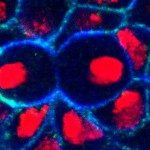Link to Pubmed [PMID] – 9603522
Nature 1998 May;393(6681):178-81
During metazoan development, cell-fate diversity is brought about, in part, by asymmetric cell divisions. In Drosophila, bristle mechanosensory organs are composed of four different cells that originate from a single precursor cell, pI, after two rounds of asymmetric division. At each division, distinct fates are conferred on sister cells by the asymmetric segregation of Numb, a negative regulator of Notch signalling. Here we show that the orientation of the mitotic spindles and the localization of the Numb crescent follow a stereotyped pattern. Mitosis of pI is orientated parallel to the anteroposterior axis of the fly. We show that signalling mediated by the Frizzled receptor polarizes pI along this axis, thereby specifying the orientation of the mitotic spindle and positioning the Numb crescent. The mitoses of the two cells produced by mitosis of pI are orientated parallel and orthogonal, respectively, to the division axis of pI. This difference in cell-division orientation is largely independent of the identity of the secondary precursor cells, and is regulated by Frizzled-independent mechanisms.

